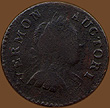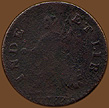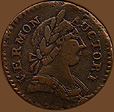Vermont Coppers, 1785-1788
Portrait varieties - 1788 continued
obverse |
|
reverse |
| |||
1788 Bressett 15-S / RR 16 Bust right - VT Copper
Obverse: VERMON . AUCTORI
Reverse: INDE ET LIB 1788
Weight: 98.5 g (6.38 grams) Diameter: 27.3 mm Reverse die alignment: 190°
Comments: The obverse die can be distinguished by the single stop that appears above the head, just to the left of the tip of the top leaf in the wreath. Also note that the R in VERMON leans somewhat so that the final stroke points at the first stroke of the M.
This is the second use of the reverse die S. It had previously been used with die 14 and was later taken to Machin's Mills in Newburgh, New York where it was combined with obverse dies 16 and 23. It can be distinguished in that there is a single exergual line which bows upward in the center. Also the hand with the branch points toward the vertical line of the D in INDE.
Provenance: From the Robert H. Gore, Jr. Numismatic Collection.
obverse |
|
reverse |
| |||
1788 Bressett 16-U / RR 25 Bust right - VT Copper
Obverse: VERMON+ AUCTORI+
Reverse: INDE+ ET . LIB+ 1788
Weight: 118.9 g (7.71 grams) Diameter: 26.7 mm Reverse die alignment: 190°
Comments: This obverse was first used with reverse die T and then with die U, later it was taken to Machin's Mills where it was combined again combined with die U to produce coppers overstruck on Irish halfpence. Later at Machin's Mills it was combined with reverse S and then once again with reverse U. Obverse 16 can easily be distinguished by the crosses in the legend and the large size head that almost touches the top rim. A die crack developed at the right shoulder just below the neck progressing through the bust and toward the R. On our example the crack is still rather light, in later stikes it is much more pronounced. Our example has a large planchet void on the head and some smaller voids at the upper rim.
This is the first and only use of reverse die U in Rupert, Vermont. The die was then taken to Machin's Mills where it was combined with obverse dies 21, 22, 16 (for overstrikes), 24, 25, 16 again and finally obverse die 22. The die can be distinguished by the crosses in the legend and the single exergual line. Bressett states the hand with the branch is opposite the upright of the D, but to me it appears to be between the N and the D.
Provenance: From the Robert H. Gore, Jr. Numismatic Collection.
obverse |
|
reverse |
| |||
1787 Bressett 17-V / RR 13 Machin's Mills Bust right - VT Copper
Obverse: VERMON AUCTORI
Reverse: BRITAN NIA . [1787]
Weight: 101.6 g (6.58 grams) Diameter: 28.8 mm Reverse die alignment: 160°
Comments: This was the first Vermont copper produced at Machin's Mills. It probably dated to soon after July 1787 when Harmon agreed to let Thomas Machin simultaneously produce Vermont coppers. James Atlee produced the obverse die and the reverse was a BRITANNIA die previously made at Machin's Mills to produce imitation British halfpence. The obverse die is usually distinguished by the round face and pointed nose on the bust. At the bottom of the bust (about 5:30 o'clock) a die break developed at the rim. In later strikes this break grows and in very late strikes it joins a vertical crack that divides the bust into two sections. The present example is an early strike with only the start of the break.
The reverse die, previously used for several imitation British halfpence, is Vlack 87C which had been combined with George III obverses Vlack 18, 19, 20, 21 and 23. (see the Machin's Mills Imitation British Coppers section for several examples). The die was either worn or intentionally filed down so it would appear worn and the Brittania reverse would go unnoticed. Most of the features are less visible than on the imitation halfpence and the date is always very weak. It can easily be identified by the legend.
Provenance: From the Robert H. Gore, Jr. Numismatic Collection.
| Vermont Coppers: p. 2 | Section Contents | Connecticut Coppers: p. 1 |
|
For viewing tips and information on optimal computer settings click
here.
For questions or comments contact Special Collections by: |





